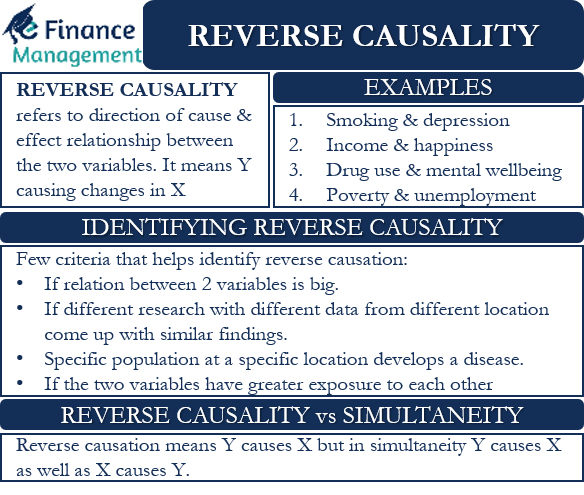Reverse Causality refers to the direction of the cause-and-effect relationship between the two variables. This relationship, however, is the opposite of the common presumption about the cause-and-effect relationship between those variables. For instance, if the common belief is that X causes a change in Y, the reverse causality will mean that Y is causing changes in X.
Another name for this concept is reverse causation. The reverse Causality concept has applications in several fields, including economics, science, and more.
We witness cases of reverse causation when people change their lifestyle after a disease or they change their habits after seeing a close family member suffer.
Example
Suppose a doctor tells a person that he has a high risk of having a heart attack because of family history or chest pain. In all probability, after the advice of the doctor and knowing that he is in the high-risk zone due to family history, such a person will go for a healthy diet and lifestyle than the general population. However, continuing with the theory, even after following a healthier diet regime, will such a person still be more likely to have a heart attack.
Yes, it is true that the practice of a healthy diet does not raise their chances of a heart attack. But, statistically, such people will continue to fall into the high-risk category despite their healthier diets. This is because most studies can not differentiate between the cases of likely cardiac events despite the change in diet. Or we can say a healthier diet has definitely reduced the chances related to diet, but there is no change or reduction in the chances associated with the family history.
Also Read: Mean Reversion Strategies
Thus, in this case, the fear of a heart attack encourages people to have a healthier diet. So, the reverse causality, in this case, is that increased risk of disease inspires people to change their diet, but such changes are either too late or too little and may not have a significant impact due to other reasons.
Examples of Reverse Causality
Following are some of the popular examples of reverse causation:
Smoking and depression is the most popular good example of this concept. Many studies have found that people who smoke tend to be more depressed. So, researchers may assume that smoking causes depression. However, the opposite of this is also possible, and it is that the depression forces people to smoke. Many people view smoking as a way to control their emotions.
Income and Happiness is also a good example of establishing reverse causation. The observational studies may find that those with higher income may report being happier overall. So, studies may conclude that higher income results in happiness. In reality, however, it may also be the case that those who are happier are able to better focus on their work and thus, earn more. Therefore, in this case, it is happiness that leads to more income.
Drug use and mental well-being is also excellent example of reverse causation. Observational studies may observe that those using drugs report lower levels of mental well-being. On this basis, researchers may assume that the use of drugs lowers mental well-being. In reality, however, there are also chances that people with lower levels of well-being are more likely to use drugs. Such a case reverses the usual relationship between drug use and mental wellbeing.
Also Read: Backwardation
Poverty and unemployment also have a reverse causation relationship between them. For economists, it is very hard to answer whether it is poverty causing unemployment or is it unemployment contributing to poverty.
Identifying Reverse Causality
Identifying reverse causation between two variables could prove challenging. There are, however, a few criteria that can help identify reverse causation. These are:

- If the relation or association between the two variables is big, then they are more likely to have reverse causation.
- If different researches with different data from different locations come up with similar findings, then the association may be reverse causation.
- Causation may also be there if only a specific population at a specific location develops a disease, with no other plausible explanation.
- If the two variables have greater exposure to each other, it also increases the likeliness of reverse causation.
Reverse Causality vs. Simultaneity
There is another term that people often confuse with reverse causality, and it is Simultaneity. Reverse causation implies that Y causes X, but in simultaneity, Y causes X, as well as X causes Y. So, we can say that Simultaneity refers to a loop where each variable has a cause-and-effect relationship with the other variable.
Final Words
Reverse Causality is a very useful concept in the field of economics. It helps economists to identify the relationships between the variables and then accordingly come up with policies and measures.
Frequently Asked Questions (FAQs)
Reverse Causality refers to the direction of the cause-and-effect relationship between the two variables. For instance, if the common belief is that X causes a change in Y, the reverse causality will mean that Y is causing changes in X.
The examples of reverse causality include the following variables:
1. Smoking and depression
2. Income and happiness
3. Drug use and mental wellbeing
4. Poverty and unemployment
Reverse causation implies that Y causes X, but in simultaneity, Y causes X, as well as X causes Y.
Reverse Causality refers to the direction of the cause-and-effect relationship between the two variables. In contrast, simultaneity refers to a loop where each variable has a cause-and-effect relationship with the other variable.

